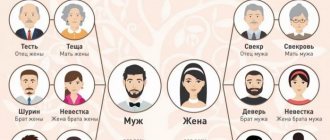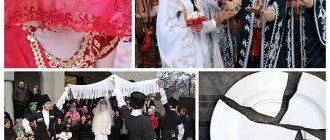Matchmaking process
An Ossetian is looking for a mate on his own. When choosing, he takes into account several points. A girl should be modest, a good housewife and sensible, and also be able to embroider and create high-quality handicrafts. Beauty comes last. If a girl is not distinguished by any quality, then even the most beautiful appearance will not help her get married successfully.
Ossetians are prohibited from forming consanguineous marriages. The selection of the bride is carried out carefully. You cannot register a marriage for people with the same surname, as well as for those whose grandmothers came from the same family.
After the chosen one is found, the young man introduces her to her parents. If the family approves of their son's choice, matchmakers are sent to the girl's house.
Choosing matchmakers is a rather sensitive issue. They can be people who have such qualities as sociability and intelligence. They must understand traditions and have a good sense of humor. Matchmakers need to convince the girl’s parents that her chosen one is worthy of her and better than others in everything.
Friends and close relatives of the groom's family become matchmakers. They are considered welcome guests in the house. But no one will give them the answer the first time. Consent to marriage is given only after the second or third meeting.
After this, the parents discuss the size of the bride price. As soon as the family receives the agreed amount, a date is set for the celebration. The decision is considered final only after the bride price has been handed over. If the monetary reward was not given on time, then the guy’s intentions are considered frivolous. This moment will become the reason for breaking off the relationship, because the groom broke his word.
It is believed that following all the traditions completely changes a girl’s life. Once she has received the status of a bride, she is prohibited from attending any entertainment events.
General information
Stages of an Ossetian wedding
Conventionally, an Ossetian wedding can be divided into several stages:
- Preparatory stage. It consists of choosing matchmakers and the actual matchmaking of the bride in her stepfather's house, paying the bride price and concluding a marriage agreement. As well as the choice of best men and the so-called “secret visit”. On it, the groom gives the bride a ring and a dress, and sweets to the future mother-in-law.
- Bride's Day. It begins with a cortege leaving for the bride to her house. Upon arrival, bargaining and ransoming of the bride takes place. The cortege, along with the bride, goes to the groom's wedding celebration. During the celebration, the bride's veil is removed; at the moment of congratulations, the future wife feeds the adult women a mixture of honey and baked milk, after which she goes into a separate room.
- Groom's day. After the wedding celebration, the groom goes to his father-in-law's house for a joint feast.
Matchmaking
All bride candidates undergo careful selection and evaluation by the groom's relatives. After the choice of the bride is approved, matchmakers (minavarta) are sent to the house of the bride's father. Their main task was to convince the bride’s relatives that the young man, like no one else, was better suited as a husband for their daughter. Matchmakers were always chosen from adult men from among close relatives. These people must have such qualities as diplomacy, patience, a good sense of humor and a good knowledge of Ossetian traditions and customs. As a rule, they tried to carry out matchmaking on Saturday in the evening. At the same time, it is mandatory to warn the bride’s family about the expected visit of guests.
At this time, guests are greeted at the bride's house by respected relatives or simply acquaintances from the bride's side. According to tradition, the parents of both parties, as well as the young couple, were not supposed to participate in the matchmaking process. It is mandatory for the matchmakers to set a table in the bride's house, at which the future union of the young people is discussed.
The bride's relatives have the right to reject the matchmaker's proposal, but this happens extremely rarely. Because before the moment of matchmaking, young people have the opportunity to get to know each other better, and at the time of matchmaking, a positive decision has already been conditionally received from the young people of both parties. In modern Ossetia, the matchmaking procedure is symbolic and conditional. However, according to etiquette, matchmakers must visit the bride's house at least 3 times. The final decision will be announced at the third meeting. After matchmaking, the bride is prohibited from attending entertainment events outside the home and meeting with relatives of her future husband.
Collusion
After receiving a positive decision from the bride's side, the groom's relatives and family send proxies (fidaujit) with money to draw up a marriage agreement. The conspiracy takes place in a festive atmosphere with a cheerful feast, with the reading of prayers and the utterance of good wishes for the two families, which after some time will become related.
Secret visit (susægtsyd)
7 days before the wedding, the groom and his friends, secretly from the bride's family, enter the bride's house. Usually, during a secret visit, the groom is accompanied by a senior and junior best man (kukhylkhatsag and amdzuardzhyn). According to Ossetian customs, groomsmen are chosen by the groom's parents from among their closest friends or relatives. A mandatory requirement for the best man was that they must already be married. In the future, the groom's best men become the bride's named brothers. Throughout her life they will protect her and help her in difficult times.
On the bride's side, at the time of such a visit, the house is attended by the older women of the family, the mother or grandmother of the bride's father, young neighbors or close relatives. During the first part of the visit, the older people are separated from the younger people in the next room. After making three prayer toasts, the groom and his groomsmen move into the next room to the older women, where the bride’s mother treats the men to national Ossetian low-alcohol beer. Having emptied their glasses, the young people return to the room with the bride. At the same time, they must fill their empty glasses with money. As gifts for the future mother-in-law, the groom brings sweets, and gives the bride an engagement ring and a wedding dress. In other words, a secret visit can be equated to the engagement of the newlyweds.
A little about the secret visit
Ossetian wedding traditions are diverse.
One of the rituals is a secret visit to the groom’s girlfriend’s house with friends. The elder, who is already married, and the younger best man must be present. After a secret visit, these people become the bride's brothers. They agree that they will protect the girl all her life. During the visit, the beloved's relatives are in the next room. Once they have made a few toasts, the future spouse will enter the room with their groomsmen. Women serve men. They must pour full glasses of wine. And after the men empty them, they invest money there.
On the day of the secret visit, the son-in-law presents the mother-in-law with sweets, and gives the future wife a wedding dress and engagement ring.
After the wedding
The rituals and traditions of Ossetian weddings do not end even after the wedding ceremony. At the groom's house, the bride's veil is removed, and this must be done by a young man, a relative. The ritual is performed with the help of a wedding flag, which is passed from the bride's house. When the veil is removed, the flag is fixed above the stove, where it should be permanently.
After the ceremony of removing the veil, the bride treats all the women in the house with honey from a special bowl, which is then given to the children. Then the bride is taken back home, where the groom and best man later arrive. Another feast is being held here.
The next morning, the bride treats local children with sweets, and the guests continue to celebrate.
Arrival for the betrothed
A few years ago, a wedding in Ossetia was celebrated in the groom’s house. Many guests were invited to the event. The festive table was placed in the courtyard. In modern times, young people prefer to celebrate their wedding in a restaurant.
An Ossetian wedding is conventionally divided into two types: the celebration of the bride and groom. In the morning, the future spouse's relatives, neighbors and friends come to his house. The eldest of the best men decides who will go in the cortege to pick up the bride, and also gives several instructions. It is mandatory for the girl's parents, senior and junior groomsmen to follow her. The retinue gives the groom's chosen one pies, cakes, sweets and alcoholic drinks.
They are greeted at the doorstep with glasses of wine. The guests wish the bride and groom well, happiness and long love. Then everyone goes into the house. The bride occupies a prominent and honorable place. But after a few minutes she is taken to an adjacent room, where she can change into a wedding dress.
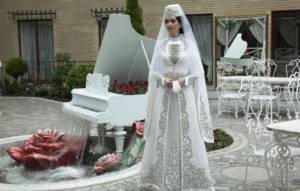
Pre-wedding rituals
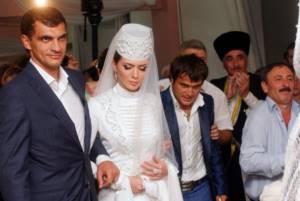
The most charming ritual in pre-wedding preparation is called “susagtsid”, which translated means “secret visit”. It is applied a few days after the fidyd has taken place. Her bridesmaids, groom and best man come to the bride's house. As a rule, everything happens secretly and in the evening. The future son-in-law must treat the female half of the house with the sweets that he brings with him. Then the guests are treated to food, and dancing begins on the street and Ossetian folk wedding songs can be heard.
At this feast, you can also hear three toasts of honor, only the third toast this time is dedicated to the happiness of the young. The mother of the bride presents her future son-in-law with a ceremonial glass, and other women present the other men. They must drink the contents to the bottom, and then put money in it and return it to the women.
On this day, the groom gives his bride a wedding ring, after which the real celebration begins with songs and dances. The festivities can continue until late at night, but the groom should not stay overnight in the newlywed's house.
Bargaining for the bride
Bargaining is usually understood as a cheerful argument during which the relatives of the bride and groom do not want to give in to each other. Often bridesmaids hide the newlywed, demanding a ransom for her. In the end, the groom's relatives manage to come to an agreement with everyone. The senior best man leads the bride out to the sounds of an accordion. Then they put her in the car and take her to the groom.
As soon as the car drives up to the house, the bride is greeted by people who want to wish her happiness in her family life. In order for a girl to give birth to a boy first, she is given the opportunity to hold a male baby. The bride crosses the threshold of her future home with her right foot.
Folk dances of Ossetia in modern culture
Today there are many Ossetian folk dance ensembles that tour not only throughout Russia but also abroad, introducing audiences to the Caucasian identity. The public always perceives such performances very warmly - after all, the spectacle is always bright and exciting. The State Ensemble “Alan”, which is almost 80 years old, enjoys particular success.
“Alan” is the winner of many competitions and festivals; he represented his native land and the whole of Russia in many countries of Europe and Asia. Ossetian dances are invariably successful in Moscow. In addition to various performances by dance groups, there are several studio schools in the capital that are constantly recruiting people who want to attend classes.
Often, Caucasians who are far from their native land enroll their children in such schools so that they absorb folk culture. However, not only people whose lives are connected with the North Caucasus come here, but also many of those who are attracted by the grace of the dance. In addition, mastery of dance techniques contributes to spiritual penetration into the ancient culture of one’s people.
Veil removal process
One of the important stages is removing the veil from the bride. It is carried out by a young man who is a friend or relative of the groom. Using a special flag, he performs the ritual. The guy moves it over the newlywed's head three times.
During the ceremony, he must wish happiness, prosperity, the birth of sons and one daughter. Then he lifts the veil. All invited guests must see the bride's face.
Another ritual is also performed. The idea is that the bride should treat her mother-in-law with a mixture of ghee and honey. Then the boys steal the jar with its contents. So they want to get ransom.
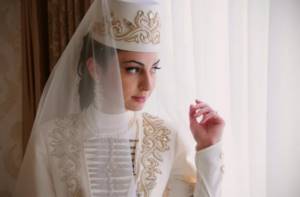
How is an Ossetian wedding celebrated?
An Ossetian wedding is distinguished by its splendor. The number of invitees exceeds 100 people. Everyone is having fun and giving gifts to the newlyweds. The parents of the bride and groom present jewelry. The rest give money.
During the wedding celebration, the newlywed is in a specially designated place. Only after a few hours she is taken to a special room and allowed to sit down. Guests can drop by to wish her all the best and mutual understanding with new relatives.
The girl must stand silently. Only occasionally does her father-in-law allow her to talk after she takes off her headscarf. In the evening, the future spouse goes to his father-in-law's house. There the mother-in-law is preparing scrambled eggs for her son-in-law. Then there is a feast and dancing.
Newlyweds, based on tradition, should not return to their home on the second day. They can only come home on the third day. But usually this rule is not followed, and the spouses return before the allotted time.
Over time, the traditions of the Ossetian wedding have undergone changes, but still remain original. Young people remember them and follow them strictly.
Outfit of the Ossetian bride and groom
The dress of the future wife is distinguished by its uniqueness and beauty. She looks great in it. This gives the image majesty, status and sophistication.
There are several features of the outfits.
- Ossetian outfits include several elements. It consists of a shirt, corset, swing dress, caftan, cap and veil. The caftan occupies a special place. It is made from expensive fabrics - silk, satin or velvet. Decorations made of gold thread are required.
- The Ossetian outfit is decorated with a bib, which has clasps. They do not perform any function and are used only as a component.
- The cut of the swing dress is characterized by severity. It should hide the heels, arms, chest and shoulder areas. But at the same time the dress fits the figure beautifully. To highlight the waist, wear a belt.
- The bride's head is covered with a cap and veil. In this way she protects herself from evil glances.
- Brides often wear light-colored dresses that are decorated with various ornaments.
If we talk about the groom’s image, he puts on a formal suit. It is no different from a Russian suit and consists of a light shirt, tie or bow tie, jacket and trousers in dark shades.
An Ossetian wedding is luxurious, expensive and unusual. Its traditions will not leave anyone indifferent. Young people still honor and respect them, thereby protecting their families from sadness, adversity and the influence of evil spirits.
Details
Outfit Details
The wedding dress of an Ossetian bride includes many details, here are some of them:
– corset – made of several layers of silk;
- a shirt (chintz or silk), red or yellow;
- a metal belt that protects the bride from evil spirits. As a rule, it is decorated with expensive red stones;
- caftan - usually made of expensive fabrics (satin, silk or velvet). Its collar hem is embroidered with gold embroidery;
- apron;
— bib (symbol of the branch of the Tree of Life);
- a hat embroidered with threads (gold and silver) and decorated with beautiful stones, usually ruby in tone;
- a veil, it can be replaced with an airy scarf, worn over the cap and covering the beauty’s face.
The entire suit is made in a swing cut. A caftan is worn on top of the shirt, which fixes the girl’s figure and prevents the fasteners on the chest from unfastening. It is almost invisible from under the dress and is considered more of a decorative element of the wedding composition. Under the caftan the girl is wearing a corset, which is tightened with a cord with multiple knots. According to custom, the corset is untied, and the use of sharp objects is not allowed. It is also prohibited to break the cord.
The sleeves of the swing dress, flared at the bottom, are embroidered with handmade embroidery and rich stones. This makes the dress very heavy, but makes it unusually beautiful and solid. In some dresses, the sleeves are straight, tapering at the wrist. Wide sleeves should be worn on such a sleeve. Ossetian wedding dresses are always luxurious and expensive. The outfit covers all parts of the bride's body, including the neck and arms.
About the headdress
The girl’s headdress (cap) is beautiful, embroidered with gold threads and framed by an airy veil made of several layers. The veil covers the newlywed's head from prying eyes. It should be noted that a veil with a wedding cap made in the shape of a truncated cone is the subject of ransom at a wedding in Ossetia. The headdress is carefully guarded by the bride and groom’s relatives, and guests try to “steal” it. In the old days, it was considered a bad omen if the bride’s headdress fell into the wrong hands. The bride's belt can be made of cloth or silver. It is believed that the richer the belt is decorated, the more prosperous the bride’s family is. The fabric belt is originally embroidered, and the metal belt is a unique masterpiece.
In the old days, the bride's dress was made of red fabric. Modern Ossetian newlyweds wear clothes in light shades (white, pink, cream, blue) with bright elements.
On her feet, the girl puts on soft shoes made of morocco (chuvyaki) with patterns embroidered with gold and silver threads.
The bride is the personification of purity and chastity. Her wedding attire amazes with its luxury and richness.
It is believed that a girl in a wedding dress is very vulnerable and susceptible to the machinations of evil forces, this explains the presence of many amulets and protective patterns.
When the bride in her wedding dress goes to the wedding procession, she is accompanied by the best man. At the same time, the girls sprinkle sugar on the road as a sign that married life will be sweet. According to tradition, this role is assigned to the mother of the bride. On the way to the registry office, the cortege, according to custom, stops at holy places for prayer.




